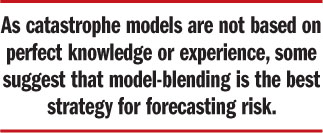Uncertainty in the science of catastrophe risk, and how this translates into modeling, has always been a hot topic, not least following Risk Management Solutions' updates to its U.S. Hurricane and Europe Windstorm models last year.
Significant new, peer-reviewed research and data led to substantial changes in the view of risk—and these models are the most informed to date. Yet despite these advances, there inevitably remain areas of uncertainty that may lead to future changes as our knowledge and understanding, as well as technology, continue to evolve.
 To use a simple analogy: The landscape of catastrophe risk can be likened to that of Mount Everest, with its steep, unstable slopes, safer plateaus and changing weather conditions. Following expeditions such as those of pioneers like George Mallory and Andrew Irvine in the 1920s—or more recently with the launch of satellites—new observations and data have resulted in new maps, with new measurements of mountain heights and more detailed topography of the slopes and valleys.
To use a simple analogy: The landscape of catastrophe risk can be likened to that of Mount Everest, with its steep, unstable slopes, safer plateaus and changing weather conditions. Following expeditions such as those of pioneers like George Mallory and Andrew Irvine in the 1920s—or more recently with the launch of satellites—new observations and data have resulted in new maps, with new measurements of mountain heights and more detailed topography of the slopes and valleys.
Recommended For You
Want to continue reading?
Become a Free PropertyCasualty360 Digital Reader
Your access to unlimited PropertyCasualty360 content isn’t changing.
Once you are an ALM digital member, you’ll receive:
- Breaking insurance news and analysis, on-site and via our newsletters and custom alerts
- Weekly Insurance Speak podcast featuring exclusive interviews with industry leaders
- Educational webcasts, white papers, and ebooks from industry thought leaders
- Critical converage of the employee benefits and financial advisory markets on our other ALM sites, BenefitsPRO and ThinkAdvisor
Already have an account? Sign In Now
© 2025 ALM Global, LLC, All Rights Reserved. Request academic re-use from www.copyright.com. All other uses, submit a request to [email protected]. For more information visit Asset & Logo Licensing.








